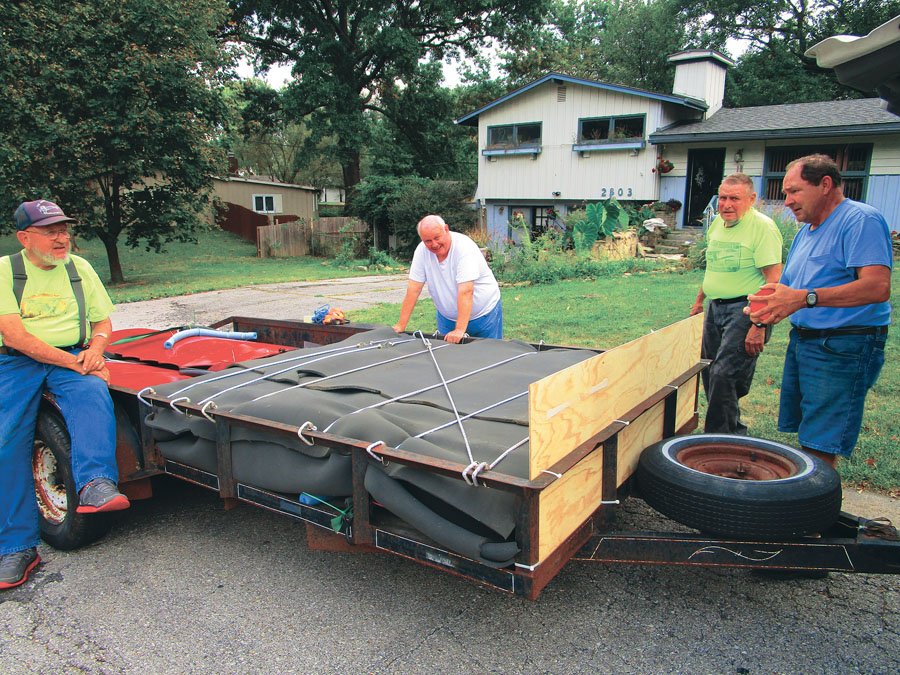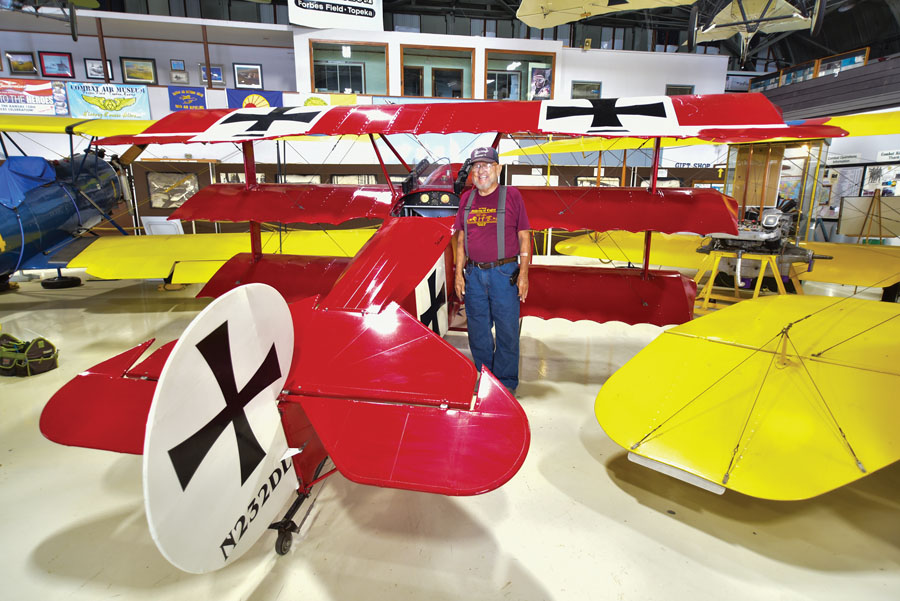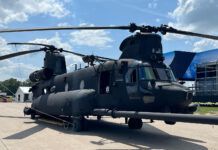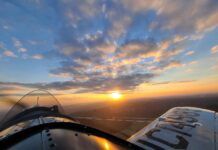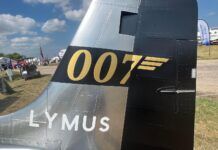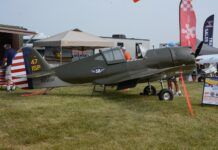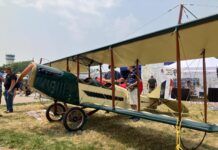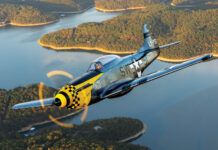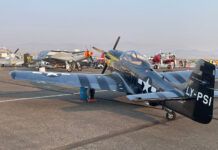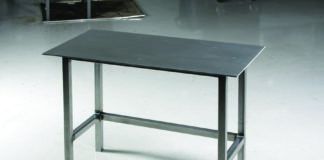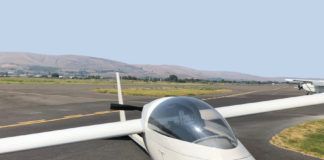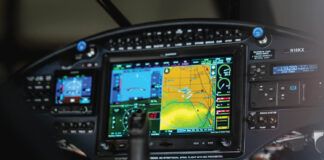“West bound and down…Twenty-six wheels a turnin’…We’re gonna do what they say can’t be done! We’ve got a long way to go and a short time to get there…We’re westbound…Just watch that old Dawn Patrol run.” (With apologies to Jerry Reed.)
Sweetie and I were singing at the top of our lungs as the Stealth Van thundered down I-70. Yup, The Dawn Patrol was on the loose and in their usual mode, heading toward harm’s way. We were in a convoy going to the Combat Air Museum located in the environs of Forbes Air Force Base in Topeka, Kansas.
We were five vehicles in a line heading west. In front was Mark Pierce towing his big eight-foot by twenty-foot heavy-duty trailer. Then came Dick Lemons in his lightweight lawn-mower trailer. The Stealth Van and two passenger cars made up the rest of the herd.

Arrival at Forbes Field. The feverish unpacking begins with the rains rapidly approaching. In the background is the massive Lockheed EC-121T-LO Warning Star. It was a Super Constellation passenger airliner modified for the Air Force. (Photo: Sharon Starks)
We were taking Dick Lemons’ beautiful Airdrome Aeroplanes Fokker DR.I replica to the Combat Air Museum. Dick had run into the same problem that Sweetie and I had run into when we had three WW-I planes to fly and only two cars to tow them to airshows and fly-ins. Too many planes and limited hangar space. If you’re a builder, the urge to build another plane in many instances says another plane has to go. We’d run into this before. My WW-I 1915 German Taube replica is hanging proudly from the ceiling of the museum. Sweetie’s beautiful Airdrome Aeroplanes DH.2 replica is also keeping the Taube company. There are several Robert Baslee designs hanging from the ceiling, too.
Both of ours were there for different reasons. The replica Taube, designed and built by me, showed everyone once and for all I didn’t know squat about designing a plane. After the crash in the corn, [“Corn on the Taube,” KITPLANES April 2004, May 2004, March 2005] and a yearlong repair job, it still flew like a loaded cement truck with flat tires. Sooner or later it was going to kill me. So, after two years of flying in different airshows, off to the museum it went. The only other option was to cut it up for scrap. There was no way I was going to sell it to some poor unsuspecting slob. The threat of a liability lawsuit was too much to even consider.
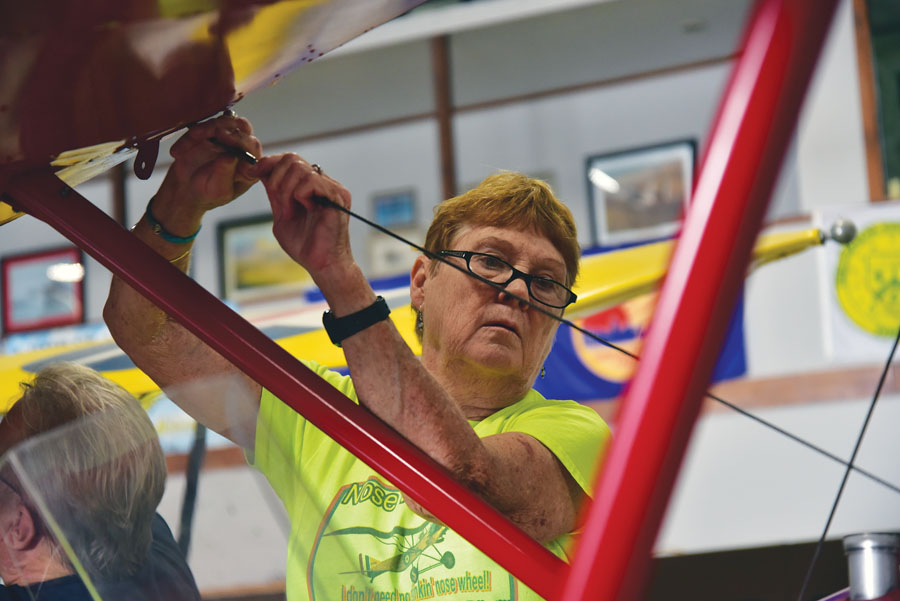
Sharon Starks works with the criss-cross bracing cables between the forward cabanes. (Photo: Klio Hobbs)
It was the same way with Sweetie’s DH.2. It was a stunningly beautiful plane that didn’t really want to fly. “Hollywood” Harvey Cleveland, our designated CFI and test pilot, flew it once. After he landed Harvey gave us the bad news. It needed a lot more wing area and a much bigger motor. We didn’t have the time, money, or energy for that big a rebuild. So, off to the Combat Air Museum it went too, also hanging proudly from the ceiling of the museum’s hangar.
The Combat Air Museum is a jewel. It possesses one of the biggest collections of WW-I aircraft you will find anywhere in the states. At last count it has nine WW-I replicas on display.
There are other museums all over the country that would love to have some WW-I planes to add to their collections. Two Kansas City Dawn Patrol aircraft are even on display in the National World War I Museum, located at the Liberty Memorial, right here in Kansas City. Glenn Huff’s Graham Lee Nieuport 12 replica and his monstrous full-scale DH.2 are there.
Butch Whitlock’s Graham Lee Nieuport 12 replica is on display in the Illinois Aviation Museum in Bolingbrook, Illinois. Rather than cut up a plane for scrap, a museum is a great way to remove a plane from your stable for other people to enjoy for years.
One thing we always do when we donate a plane is put it in writing that the plane must never be flown again. To help ensure that it can’t fly again without a lot of trouble, we remove the engine and instrument panel from the plane and install dummy instruments. Controls are removed, and movable control surfaces are bolted and locked in place.
Road Trip
After we contacted the museum and found out they really wanted the plane, we had to get it there. This was going to be a very big deal to do. Much, much easier said than done.
Our Nieuports and Sharon’s Airdrome Aeroplanes Morane Parasol come apart comparatively easy. The Nieuports take a little over an hour and a half from flight ready to trailer ready. The Morane takes even less. That’s why we still trailer them to airshows.
The Fokker DR.I takes four men sweating bullets and swearing colorfully two days to take apart. While this ordeal by fire is going on, Sharon stands by with a bucket for nuts, bolts, and washers yelling encouraging words.
It was for that reason we entertained taking the Fokker to the museum assembled. It might have worked too. We were going to pull the engine and tail feathers and stand the plane up on its nose on the trailer with the wings parallel to the centerline on the highway. When we did that, the plane stood on the trailer 13 feet 6 inches tall from the road to the tip of the fuselage. The absolute maximum height for anything on the Kansas Turnpike is 14 feet.
You know, we just weren’t really comfortable with that six-inch leeway. Plus we didn’t know what kind of overhead clearances we were going to encounter on the drive down Southwest Topeka Boulevard to the Museum.
So, it had to come apart. Like I said, it took two long days to do, but by the end, everything was ready to go. The top and middle full-length wings were on the big trailer. The fuselage was on Dick’s smaller trailer. The short bottom wings, tail feathers, guns, and everything else was in the Stealth Van with me and Sweetie.
A new feature in our convoy was a big 6-foot by 7-foot painting that was also being donated to the museum. There’s more about the painting later in the story.
Wednesday morning, October 4, the weather forecast was forbidding. But for Thursday through Saturday it was even worse. We were faced with scattered strong storms Wednesday, but from then on, it was even more threatening.
So, watching the radar on our iPads and iPhones, we blasted off from beautiful Liberty Landing International Airport, heading west on the Kansas Turnpike. Monique, our GPS, said it was going to take a little more than an hour and a half to get there.
Mark was leading with the wings and painting. Dick Lemons was following with the fuselage. Sweetie and I were bringing up the rear in the Stealth Van. The other two cars with tools and helpers brought up the tail of the snake.
I was in the zone, heading down the highway and trying to imagine all the problems we were going to encounter putting the bird back together. Light mist and rain were all we’d encountered so far. The trip was looking good!
Like I said, I was in the zone and never expected it: Like a fer-de-lance snake striking out from under a bush, Sharon attacked me from four-o’clock low. She reached over and plucked out one of my nose hairs.
“Ouch! Dang woman! Why’d you do that?” I yelled.
“Well,” she retorted, “It was so long it looked like a party favor coming out of your nose! I won’t go into that museum with an old man with hairs sprouting out of his nose like a Fourth of July fireworks fountain! Either you pull the rest of them or I will.”
There was a long wounded silence, then I quietly said “Thank you” in a small voice. (It was one of my favorite hairs though.) I got all the rest plucked to her satisfaction before we hit the turnpike tollgate. (However, on a side note, it is a heck of a way to keep you from getting sleepy while driving.)

Looking from the catwalk at the Fokker being assembled, surrounded by other aircraft at the museum. (Photo: Klio Hobbs)
Day at the Museum
We reached the museum and they were ready for us. The big hangar doors were open, and we’d barely backed the trailers in when the skies opened up and rain started coming down in buckets.
The painting was taken in first, unwrapped, and found to be in perfect condition. No damage or wet spots.
The wings were the easy parts to transport to where they wanted us to assemble the tripe. They could be slid along the floor under the planes in the hangar.
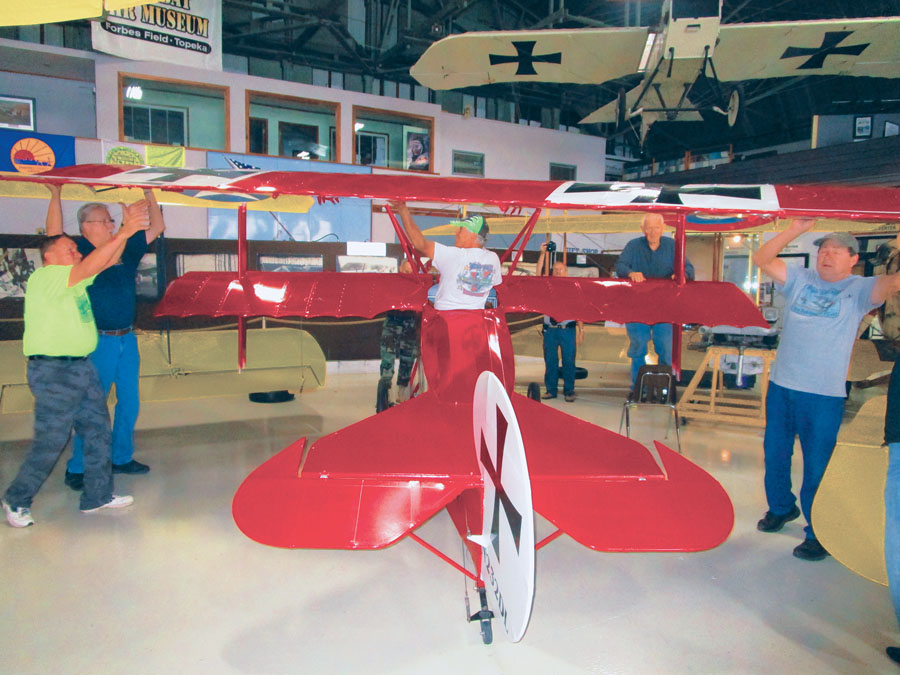
Putting the top wing in place. From left to right: Dick Starks, Chuck Watson, Kevin Drewelow,Dennis Brooks, Klio Hobbs, Ron Rollins, and Mark Pierce.
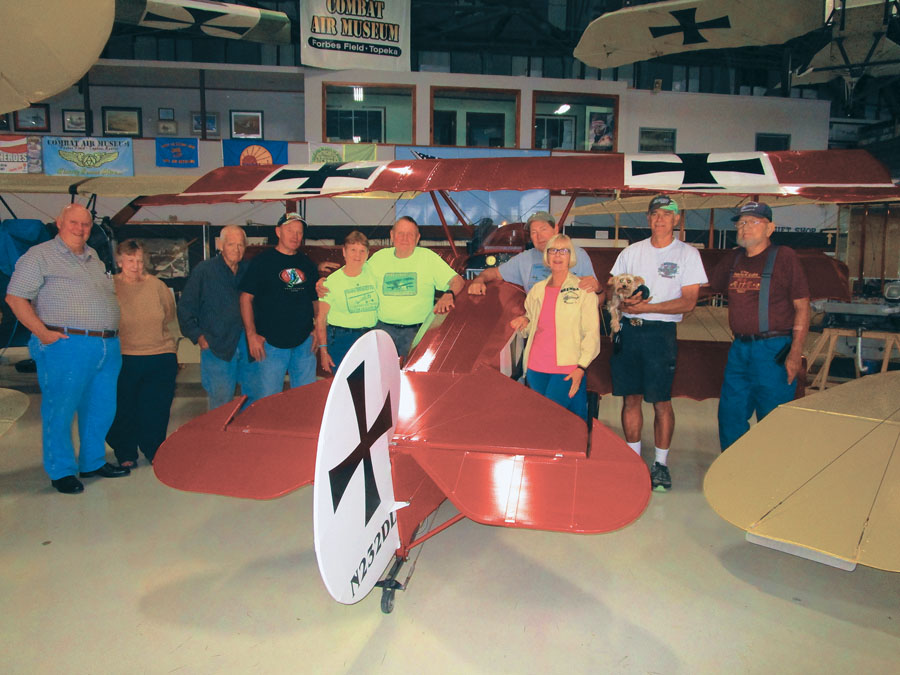
Done. The Liberty Landing International Airport construction crew stands by the newest addition to the Combat Air Museum’s collection of WW-I aircraft.
Getting the fuselage over there was a different story. We had to go around the perimeter of the display aircraft to find a path that might work. Everything went great until we tried to pass under the right stabilator of the F-4 Phantom. We needed another inch to clear it. Some inspired butt scratching and head scratching ideas were presented and discarded. Finally we found if we raised the tail really high it lowered the nose far enough for the cowl and fuel filler neck to scrape by.
We were ready to turn and burn.
Assembly started with a vengeance. Dick Lemons, Ron Rollins, and I started on the tail feathers.
Mark Pierce, Dennis Brooks, Vernon Petre and Sharon were mounting the center wing. It was the big challenge.
Dick Lemons and I were lying on our backs under the tail feathers hooking up cables, struts, and tightening everything down. We got it finished and were ready to move on to the wings with everyone else.
I laid there a while and finally looked over at Dick. “Lemons,” I whispered. “I can’t get up.”
“Neither can I,” he whispered back.
We’re both at the younger end of our seventies. His hips are bad. After a bad fall, my right shoulder was trashed and is now a metal and Teflon combination. I’m limited to 20 pounds of anything with my right arm. We’re also both badly out of shape.
So, for a while we just laid there like two stranded walruses on a beach in the Arctic. Vernon Petre finally came over and helped Dick get up.
No one noticed me or came to help. Like Randy in the movie, A Christmas Story, I laid there like a slug. Finally, I was able to crawl over to the landing gear of the Meyers OTW, and using it, I climbed up to my feet.
With eight people all working together, the rest of the assembly went much faster than any of us could have imagined. When all was said and done, the new addition to the museum was gleaming like a red diamond surrounded by a sea of yellow. It’s beautiful.
Now, about the painting…
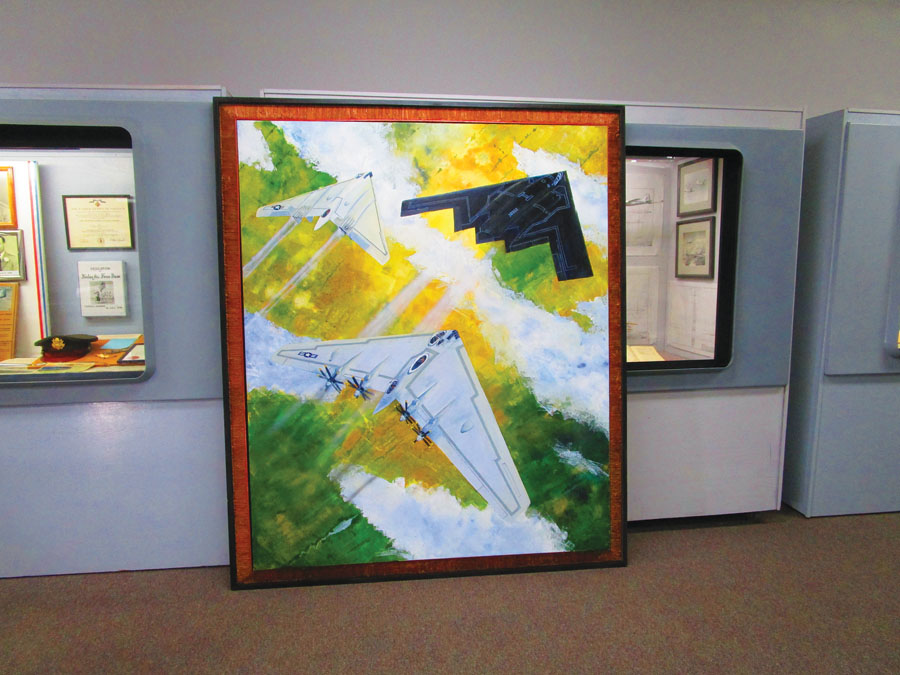
Painting details: XB-35 prop-driven flying wing (bottom), jet-powered YB-49 flying wing (top left), and B-2 Spirit (top right).
Evolution of the Spirit
L.D. Herman is a well-known Kansas City artist. His works have been viewed all over the Midwest. His murals can be seen in parks in the Kansas City area. L.D. has won many “timed artists” competitions in the Kansas City area and also served in the U.S. Army as a Redeye missile gunner.
In August 2014, in a move he attributed to a “momentary lapse of reason,” he purchased a 6-foot by 7-foot canvas. He said the price was too good to pass up; the price was cheap probably because no sane person would even think of painting a picture that large…or know where to display it.
The canvas sat in a storage area for months while L.D. waited for inspiration to strike. L.D. attends a painting class at a local church every Tuesday. While there, he works on his paintings and helps other struggling artists. By chance Sweetie and I attend the same class. Sharon paints in oils and I build WW-I plastic models.
L.D. and I started to talk about different planes that have always fascinated us. When we started talking about the B-2, the fuse was lit. Researching the history of the B-2 led us to John Northrop’s development of the XB-35 and YB-49, the first strategic flying-wing bombers. It was a fascinating look at government bureaucracy and blatant corruption at its worst. L.D. decided to do a painting entitled “The Evolution of the Spirit,” which depicts all three planes.
L.D. slowly reeled me into his web, and in another momentary lapse of reason, I agreed to help plan the layout of the painting. We bought detailed 1/72-scale models of the XB-35, the YB-49, and the B-2 Spirit. After building the models, we started arranging them in different formations on a very large 8-foot by 6-foot table. We photographed them trying to see what formation would best fit the dimensions of the canvas. We finally decided on a “V” formation, as it would be viewed from a chase plane flying in the 4 o’clock high position. L.D. started painting in April 2015. It was finished in July 2016.
When we arrived at the museum, it became clear why the museum was so interested in obtaining the painting. We found out that the pilot of the YB-49 that perished in the crash was U.S. Army Major Daniel Forbes for whom Forbes Air Force Base was named. The copilot was Captain Glen Edwards for whom Edwards Air Force Base is named. We didn’t know that.
The painting has truly found its best home.
Our mission was a complete success—with none of the usual drama or visible wounds either! The Fokker and painting are in their new home, so The Dawn Patrol’s adventures can continue.

![]()
Dick Starks has written two books about the joy of flying; “You Want To Build And Fly A What?” and “Fokkers At Six O’clock!!” He was the recipient of Flying’s 2001 Bax Seat Award “for perpetuating the Gordon Baxter tradition of communicating the excitement and romance of flight.” Dick and his wife, Sharon, both fly WW-I replica aircraft.


